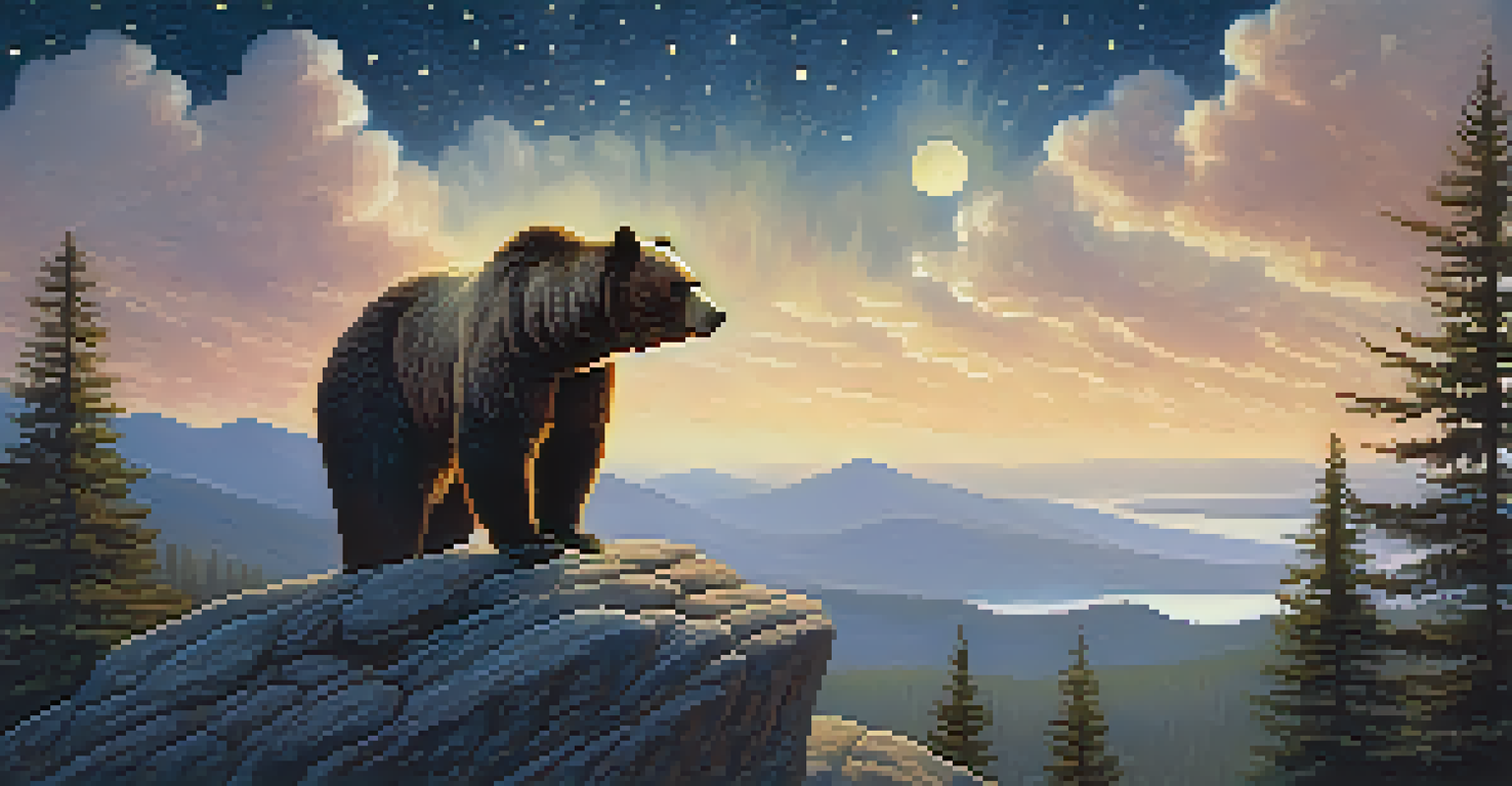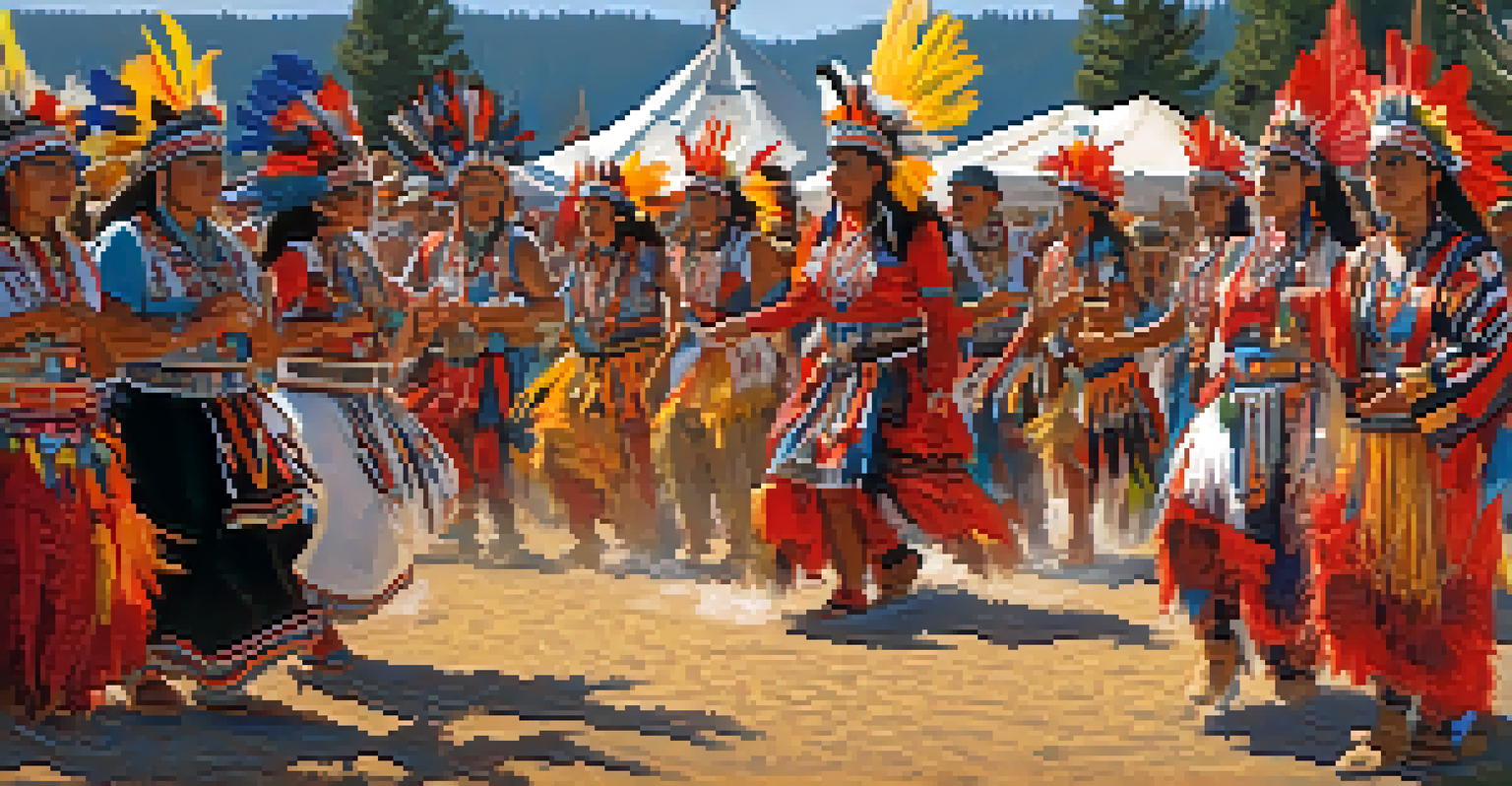The Mysterious Origins of Big Bear's Native Folklore Tales

Understanding the Rich History of Big Bear's Folklore
Big Bear, nestled in the San Bernardino Mountains, is not just a beautiful getaway; it’s a treasure trove of Native American folklore. The stories that have been passed down through generations reflect the deep connection between the indigenous peoples and their natural surroundings. These tales often feature animals, spirits, and the elements, illustrating the values and beliefs of the tribes that once inhabited the region.
Stories can conquer fear, you know. They can make the heart bigger.
The origins of these folklore tales can be traced back to the Serrano and Cahuilla tribes. They used storytelling as a way to explain the world around them, impart wisdom, and preserve their history. Each story serves as both entertainment and education, helping younger generations to understand their culture and environment.
As we delve into the folklore, we find that these narratives are more than just fanciful tales; they are rich with meaning. They often convey moral lessons, highlight the importance of harmony with nature, and share the consequences of human actions. Understanding these stories provides us with a glimpse into the values that shaped the lives of the indigenous peoples of Big Bear.
Key Themes in Big Bear's Native Folklore
One of the most prominent themes in Big Bear's folklore is the harmony between humans and nature. Many stories depict animals as wise beings that guide humans in their lives, showcasing the importance of respecting wildlife. This theme resonates with the idea that every creature has a role in the ecosystem, a lesson that feels particularly relevant today.

Another recurring theme is the presence of supernatural beings and spirits that influence the lives of both humans and nature. These spirits are often portrayed as guardians or tricksters, adding an element of intrigue to the tales. They remind us of the unseen forces that shape our world, illustrating the balance of good and evil.
Folklore Connects Community to Nature
Big Bear's folklore emphasizes the harmony between humans and nature, illustrating the importance of respecting wildlife and their roles in the ecosystem.
Additionally, the concept of transformation plays a significant role in these stories. Characters often undergo physical or spiritual changes, reflecting personal growth or the consequences of their actions. This theme encourages reflection on our own journeys and the changes we experience throughout our lives.
Famous Folktales from Big Bear
One of the most famous tales is the story of the Bear Spirit, a guardian that watches over the mountains and its inhabitants. According to legend, the Bear Spirit protects the land from those who would harm it. This tale not only highlights the reverence for wildlife but also serves as a reminder of the balance between nature and human activities.
Folklore is the glue that binds a culture together, providing a shared sense of history and identity.
Another popular story is that of the Coyote, often depicted as a trickster figure. Coyotes are known for their intelligence and cleverness, and in these tales, they often teach valuable lessons about cunning and survival. This character serves as a reminder that not everything is as it seems, and sometimes, wit is just as important as strength.
The Legend of the Star People is also a significant folktale, explaining the connection between the stars and the indigenous people. This story illustrates how the night sky was seen as a map of guidance and hope, showing that folklore often blends the earthly with the cosmic, creating a rich tapestry of belief.
The Role of Storytelling in Native Culture
Storytelling has always been a vital part of Native American culture, serving as a way to preserve history and pass down knowledge. In Big Bear, storytelling gatherings would often take place around a fire, fostering community and connection. This tradition allows the oral history to thrive, ensuring that the tales remain alive through generations.
As stories were shared, they also became a means of teaching important life skills and values. Elders would share experiences from their own lives, using stories to illustrate lessons about respect, courage, and the importance of community. These narratives not only entertain but also educate, creating a rich learning experience for listeners.
Storytelling Preserves Cultural Identity
Storytelling in Native American culture serves as a vital means of preserving history, imparting values, and fostering community connection.
Moreover, storytelling is seen as a form of spiritual practice. Engaging with these tales allows individuals to reflect on their place in the universe and their connection to the land. This aspect highlights the deeply rooted spirituality within these stories, emphasizing that they are not just entertainment but a way to connect with one’s heritage.
Preserving Native Folklore in Modern Times
As society evolves, preserving the rich tapestry of Native folklore remains crucial. Today, efforts are being made to document and share these stories through various mediums, including books, art, and performances. This preservation ensures that the wisdom and values embedded in these tales continue to inspire future generations.
Community events and cultural festivals play a significant role in keeping these traditions alive. By gathering to share stories, music, and dance, communities reinforce their identity and promote awareness of their heritage. These events not only celebrate the past but also encourage younger generations to participate and learn.
Additionally, technology has opened new avenues for sharing folklore. Digital storytelling platforms allow for wider reach, making it easier for people to engage with these narratives. By embracing modern methods of communication, we can ensure that the essence of Big Bear's folklore is not lost but instead thrives in a contemporary context.
The Impact of Folklore on Local Identity
Folklore plays a significant role in shaping the identity of the Big Bear community. The stories reflect the unique history and cultural background of the indigenous tribes, fostering a sense of belonging and pride among residents. This connection to the land and its legends strengthens community ties and promotes a deeper appreciation for local heritage.
Moreover, the tales serve as a bridge between the past and present, helping to raise awareness of the struggles and resilience of Native peoples. By sharing these stories, the community can honor their ancestors while also educating outsiders about their rich history. This dialogue fosters understanding and respect among diverse groups.
Modern Efforts to Preserve Folklore
As society evolves, initiatives like community events and digital platforms are crucial for documenting and sharing Big Bear's rich folklore with future generations.
In essence, folklore is not just a collection of old tales; it is a living part of the community's narrative. It encourages individuals to connect with their roots, reminding them of their place within a larger story that spans generations. This ongoing relationship with folklore reinforces the importance of cultural preservation in today's society.
Conclusion: Embracing Big Bear's Folklore Legacy
The mysterious origins of Big Bear's Native folklore tales offer a fascinating glimpse into the culture and beliefs of the indigenous peoples. Through these stories, we not only entertain ourselves but also learn valuable lessons about respect, harmony, and the power of nature. They remind us that every tale carries a legacy worth preserving.
As we embrace the folklore of Big Bear, we also acknowledge the importance of storytelling in shaping our identities and fostering community connections. These narratives serve as a vital link to the past, enriching our understanding of the present and guiding us toward a more sustainable future.

Ultimately, by sharing and celebrating these tales, we honor the wisdom of those who came before us, ensuring that their stories continue to resonate for generations to come. The legacy of Big Bear's folklore is a treasure that enriches both the local community and all who seek to understand the deeper connections we share with the world around us.